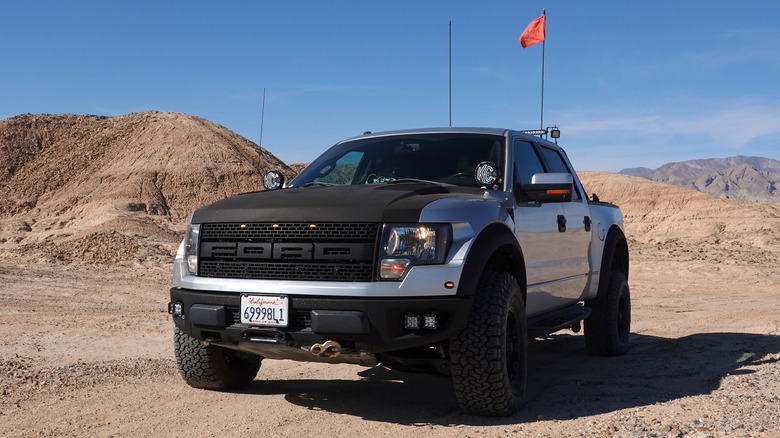
Simone Hogan/Getty Images
Pickup trucks have a very simple concept: A more rugged vehicle with a long, open cargo area designed to haul various heavy loads, certainly heavier than most normal cars could manage. Classic pickup trucks didn’t have much in the way of comfort features or refinement. Over time, however, automakers started exploring various ways to take them to the next level. Sometimes that meant tackling even rougher stuff, outfitting them with a smattering of luxury features, or making them fast enough to outrun some of the best performance cars.
Today, new pickup trucks have all sorts of must-have features. They’ve gotten so advanced and so capable, they can easily be the only car on your driveway. They’re truly do-it-all machines. But while the advancements in modern pickup trucks are very impressive, sometimes simpler is better. Older pickup trucks are becoming more popular among enthusiasts and collectors, as they represent a time when pickup trucks were merely tools, thus increasing their perceived cool factor.
As Classic.com shows, some older pickup trucks that no one really batted an eye at before are now worth a lot more money than expected.
GMC Sierra (GMT800)
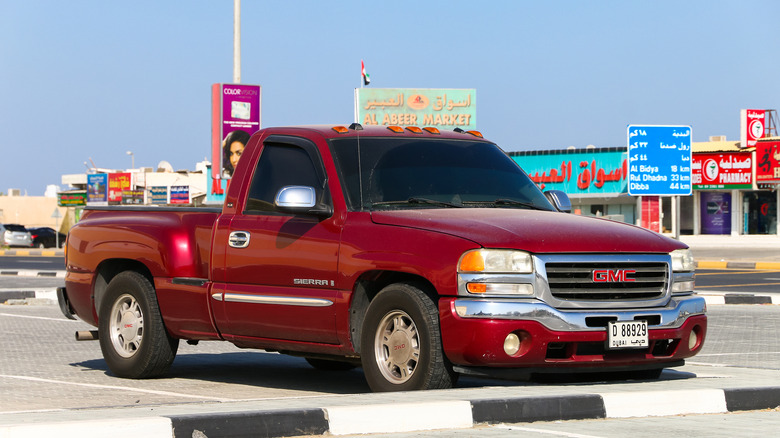
Darthart/Getty Images
By the late 1990s, GM was preparing to retire the ancient C/K pickup truck series. In 1998, the replacement arrived in the form of the GMT800-based pickups. Chevy’s version was named the Silverado, after the C/K’s highest trim level, whereas GMC’s version kept the name Sierra. The GMT800 Sierra featured various luxuries, without sacrificing the capability you’d expect from a pickup truck.
Between the Silverado and the Sierra, the latter of the two is the more interesting one, due to a certain trim level introduced in the early 2000s. That was the Sierra C3, which was one of the world’s first proper luxury pickup trucks, in the same vein as the Lincoln Blackwood and Cadillac Escalade EXT. The Sierra C3 would go on to be renamed the Sierra Denali, and the rest is history.
Power came from a lineup of third-generation General Motors V8 powertrains, including the 4.8-liter and 5.3-liter Vortec units, as well as the 6.6-liter Duramax diesel in the HD variants. Thanks to the GMT800’s legendary reliability, decent refinement by modern standards, and its old-fashioned approach to capability, a good low-mile example of the GMT800 Sierra (yes, they still exist) will set you back around $20,000.
Ford F-100
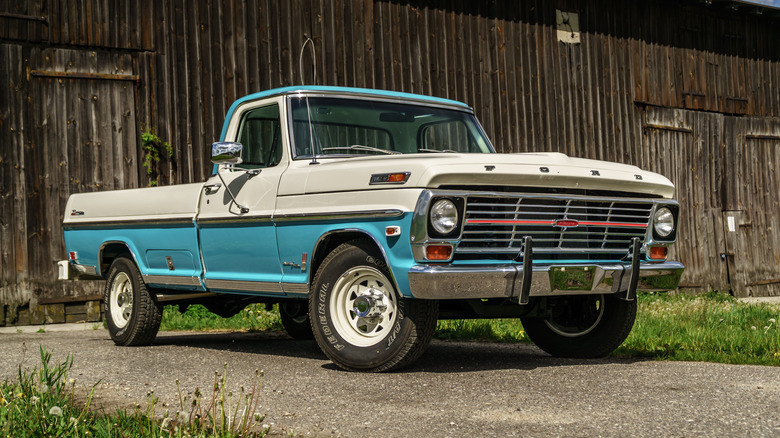
Jakub Baczyk/Getty Images
Here’s something that’s easy to forget: Ford’s F-series of pickup trucks has been around since 1948, and it’s currently in its fourteenth generation. Not many vehicles can claim the title of having so many generations, but that’s just what happens when something is the best-selling vehicle in the world. The first couple of generations carried the name F-1, before switching over to F-100.
The F-100 first appeared in 1953, and it’s one of the most popular classic pickup trucks on the used market right now, especially for modification and restomod projects. Over time, the F-100 would lose its 1950s rounded styling, in favor of boxier, more utilitarian lines mirrored in the modern F-150. The fourth generation F-100 started offering four-wheel drive, while the fifth generation, produced from 1967 to 1972, would gain a better interior and more room.
For the fifth generation, the F-100 received power from about a dozen different powertrains, including several diesels for the South American market, as well as your usual fare of V8s and I6es for North America. Due to its simplicity and its ladles of old-school cool, a good F-100 will set you back just over $20,000 — at least, assuming you can find one that hasn’t been modified. Those have jumped well into the 50K range, and some of them way, way more than that.
Ford F-150 Raptor (first generation)
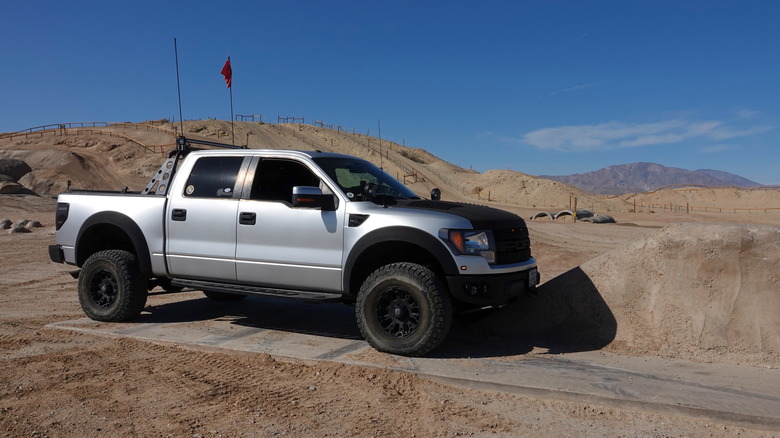
Simone Hogan/Getty Images
15 years ago, there wasn’t really such a thing as a factory off-roader pickup truck. Most factory off-roading duties were reserved for options like the Land Rover Defender, and crazy off-road pickup trucks were just an idea. Then Ford came in and changed everything. In 2009, it introduced the F-150 SVT Raptor, incidentally one of the last ever vehicles to carry the Special Vehicle Team badge. Based on the 12th generation F-150, the Raptor was designed to go off-road — quickly.
Under the hood, buyers were given a choice between a 5.4-liter Modular V8, or the much meatier 6.2-liter Boss V8 plucked from the Super Duty family. The 5.4 put out a pretty good 320 hp, whereas the 6.2 bumped that up to 411 hp. These were pretty major numbers from a pickup truck and they allowed the Raptor to accelerate to 60 mph in 8.2 seconds with the smaller engine, or 7.4 seconds with the larger engine.
In the case of the Raptor, the top speed was almost irrelevant, except for the fact that it could achieve high speeds on any terrain, thanks to its standard BFGoodrich mud tires, uprated Fox shocks, skid plates, and massive amounts of suspension travel. Today, off-road pickup trucks are big business, so it’s unsurprising that first-generation F-150 Raptors haven’t really lost any value at all. Lower mileage examples with few or no mods will set you back a little over $30,000.
Toyota Tacoma (first generation)
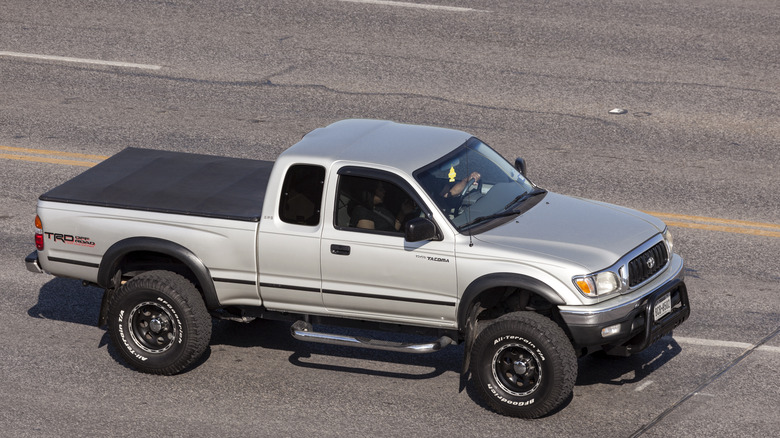
Typhoonski/Getty Images
For years, Toyota’s pickup truck offering in North America was simply called the Toyota Pickup, and it wasn’t all that different from everyone’s beloved Hilux. Still, the pickup truck market in North America was very different from that of, say, Africa or Australia. When Toyota decided to overhaul its load-lugger, it devised a pickup truck that would be much more appealing to buyers in the U.S. and Canada. The end product would bear a very familiar name: Tacoma.
Introduced in 1995, the Tacoma was quite a bit larger than the outgoing Pickup, and it featured a lot more creature comforts, to bring it closer in line with the competing Ford Ranger and Chevy S10 (which would eventually become the Avalanche). A trio of powertrains took care of driving the wheels, including two high-capacity four-cylinders and one V6. Four-wheel drive was available, along with various bed and cab configurations.
Today, the first-generation Tacoma has become something of a legend for being virtually indestructible. As a result, most owners got a lot of use out of them. It’d be much easier to find a unicorn than a low-mile, well-preserved Tacoma, and if that ever happens, $20,000 or more is the norm.
Chevrolet C/K
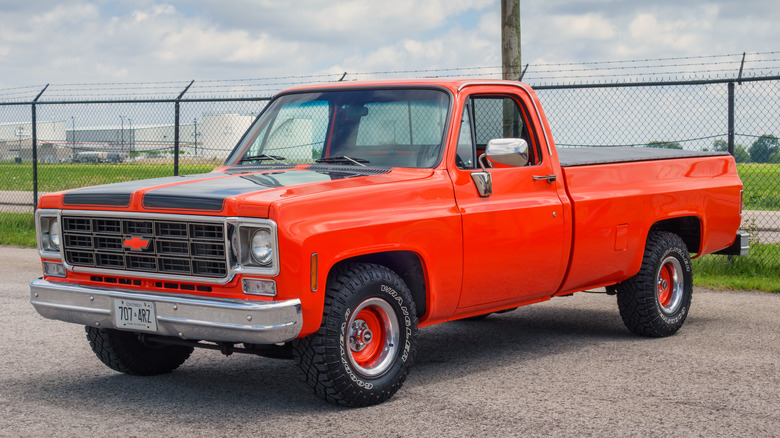
Benedek/Getty Images
Before the Sierra and Silverado became the mainstays, General Motors’ answer to the Ford F-Series was the C/K family of pickups. Introduced in late 1959, the C/K trucks replaced the Task Force line of trucks, and they were all about utility. Right from the start, they offered features you would also expect to find in more normal vehicles in Chevy’s lineup, and four-wheel drive was available right from the get-go.
Gone were the Task Force trucks’ solid axle front, being replaced by independent suspension. The C/K powertrains included your standard fare of I6 and V8 power, including one of the best engines to find a home in a Chevy truck, the original small block 350 ci V8. The second-generation C/K would introduce leaf springs, more powerful engines, and the more luxurious Cheyenne and Sierra trim levels on the Chevy and GMC sides, respectively.
The C/K also formed the basis for one of the car world’s all-time favorite off-road SUVs, the K5 Chevy Blazer and GMC Jimmy. The styling is typical classic pickup truck, and the C/K remains one of the most recognizable trucks to this day. As a result, the values of C/K trucks have gone through the roof, with the nicest, most original examples going for well over $70,000.
Toyota Tundra (second generation)
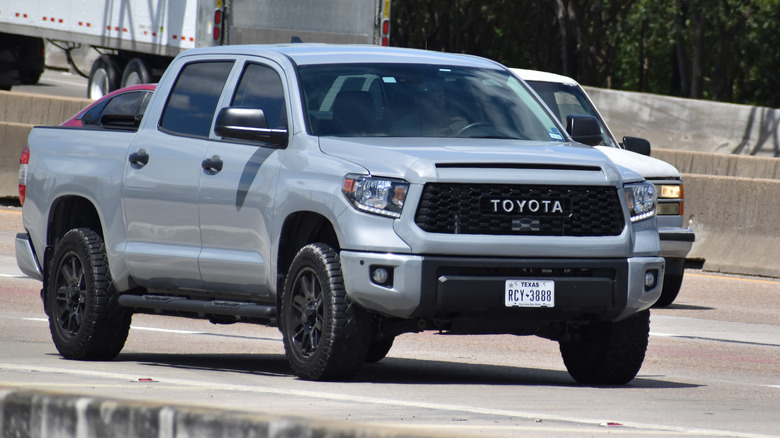
Artistic Operations/Getty Images
Alongside the Tacoma, Toyota also offered the T100 pickup, which was a larger truck also aimed squarely at U.S. tastes, to compete with pickup truck segment leaders in the U.S. By the late 1990s, the T100 became the Tundra, and it sat at the top of Toyota’s pickup truck lineup as its most capable flagship truck. The first-generation Tundras were very similar to the Tacoma, but the second generation rolled around in 2006 and took some major steps to differentiate itself.
For starters, it was way bigger than the Tacoma, which had only grown slightly by its second generation. The Tundra had the Ford F-150 and Chevy Silverado firmly in its sights, and for that, there was another major change: the second-generation Tundra added another, significantly larger V8 engine to its engine roster.
The dependable Toyota favorites like the 4.0 V6 were still available, but the 5.7 V8 was the most performant out of the lineup, offering up a very healthy 381 hp. Despite some minor reliability issues, the Tundra with the 5.7 V8 can run pretty much forever if you take care of it. It soldiered on for around 15 years, and well-maintained examples with less than 100,000 miles can easily go for $30,000. Especially well-preserved examples from the later model years go for over $40,000.
Dodge RAM SRT-10
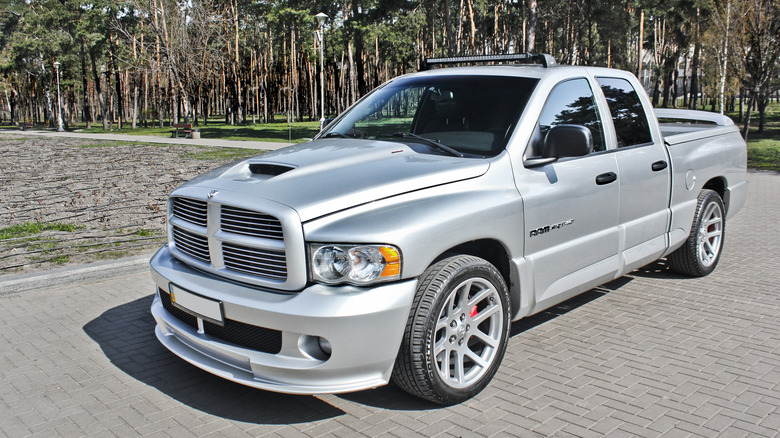
Roman Stasiuk/Getty Images
Many would say that Dodge went berserk recently, with its penchant for installing the Hellcat V8 into literally anything with enough room in its lineup. But actually, Dodge has always had a penchant for crazy, almost nonsensical production cars. In the early 2000s, it was looking for something to stick the Viper V10 engine into, and the only vehicle in the lineup with enough room for it was the RAM pickup. It made no sense, but Dodge did it anyway.
In 2004, the world was introduced to the RAM SRT-10, to this day one of the most ridiculous production pickup trucks of all time. It was never about the utility or the capability, it was simply designed to put a smile on your face. Under the hood was the 8.3-liter V10 engine from the Viper, practically unchanged from its application in the bonkers sports car.
500 hp and 525 lb-ft of torque were dispatched to the rear wheels through, at least on the single cab version, a six-speed manual transmission with a shifter that made the middle seat about as useful as a traction control button would have been. Except, the RAM SRT-10 didn’t have that either. Due to its sheer insanity, a used RAM SRT-10 is anywhere from $20,000 with higher miles, all the way to an astronomical $70,000 for museum condition examples.
Ford F-150 SVT Lightning
Everyone knows the modern-day Ford F-150 Lightning, Ford’s first electric pickup truck. It was hot stuff when it was first announced, and then Ford decided to abruptly cut production. Before the Lightning name found its way on Ford’s battery-powered truck, it was on the back of the quintessential street truck of the 90s and the 2000s. The first SVT Lightning was among the first projects of Ford’s Special Vehicle Team alongside the Fox Body Cobra, but the second generation is more fondly remembered.
Car enthusiasts of a certain age will remember Brian O’Connor pulling up to Toretto’s Market in a red F-150 Lightning set to «Deep Enough» by Live in «The Fast and The Furious.» Ford’s street truck may have used the standard F-150 base, but everything else was substantially different. Under the hood was a 5.4-liter supercharged V8, which put out 380 hp and 450 lb-ft of torque, which nudged and even bested a lot of sports cars at the time.
That power went to the rear wheels through the standard issue four-speed automatic transmission. As well as the sporty aero kit, the F-150 SVT Lightning was blessed with a fantastic piece of kit on the exterior: side pipes. 0-60 mph took just 5.8 seconds, on par with a lot of serious performance cars of the day. A good F-150 SVT Lightning will easily fetch anywhere from $30,000 to $40,000.
Chevrolet SSR
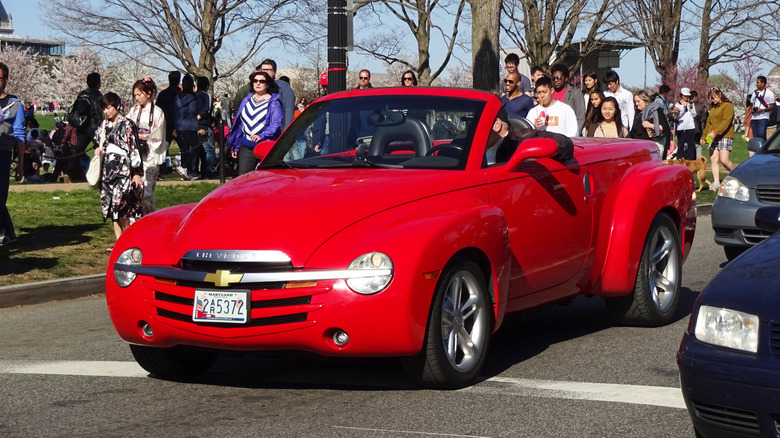
Coast-to-coast/Getty Images
No matter how good of an idea something seems, sometimes, it’s just not a very good idea to turn it into reality. Nobody told this to Chevy’s product planners in the 2000s, who decided it was a good idea to put together a pickup truck with retro styling inspired by Chevy’s historic trucks, a covered bed, and a folding metal roof. The end result was the Chevrolet SSR, a convertible truck that failed in the market. It’s easily one of the most controversial cars to come out of Chevrolet in the early 2000s — and the competition was pretty stiff in those days.
Of course, as if all that wasn’t enough, the SSR was also a bonafide performance truck. Initially, Chevy offered it with a 5.3-liter naturally aspirated V8, later replacing it with a more powerful 6.0-liter LS V8 with 390 hp, as well as giving buyers (what few there were) the option of a proper manual transmission. The result was a retro-styled pickup convertible that could reach 60 mph in just 5.5 seconds.
That’s really impressive — the base model Civics that would end up being gapped wouldn’t have any idea what hit them. While people hated, and most of them still hate the SSR, a lot of enthusiasts have come around to it these days. Due to its rarity and its especially head-turning design, used SSRs have stayed pretty valuable, pushing $50,000 for the best preserved manual examples.
Ford Super Duty (first generation)
While Ford offered heavy-duty trucks pretty much since the beginning, the first Super Duty trucks only ever became a thing in 1999, based on the F-Series’ 10th generation. As was the norm back in that day, the Super Duty family — consisting of the F-250, F-350, and F-450 — were all designed to carry and tow much heavier loads than the F-150. Their immense capability was achieved through the only feasible way: power and displacement.
As well as a lineup of high-capacity gasoline engines, the Super Duty family received the Powerstroke diesel V8 units, some of Ford’s most reliable engines. The indestructible 7.3 Powerstroke was initially offered until it was replaced by the easily destructible (if you try to increase its output, at least) 6.0 Powerstroke. If you wanted the heaviest lifting without burning oil, there was also the truly bonkers 6.8-liter Triton V10, a powertrain that time seemingly forgot.
The Super Duty also formed the basis for one of the largest, most capable SUVs of all time, the Excursion. As befits such a vehicle, first-generation Super Duty trucks were used a lot, and they’ve endured quite a long time. Combined with their simplicity, it’s easy to see why a first-generation Super Duty truck in great condition can easily cost $40,000, or more.